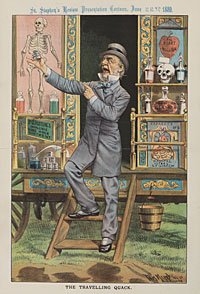|
 Quack, Quack, Quack, on view at the Grolier Club from September 18 to November 23, 2002, showcases the often flamboyant sellers of nostrums and patent medicines over the course of four centuries, through visual, often entertaining, material. Quack, Quack, Quack, on view at the Grolier Club from September 18 to November 23, 2002, showcases the often flamboyant sellers of nostrums and patent medicines over the course of four centuries, through visual, often entertaining, material.
The exhibition is divided into ten sections. These range from the ways of itinerant quacks, their use of various extravagant marketing techniques, the frequent bitter rivalry between sellers of panaceas, each with his or her own theory supported by dubious claims of efficacy; to quacks in the arts and, finally, to the first governmental restrictions on the more flagrant abuses.
The quack over time has been both a popular and profitable subject for artists and writers from Europe and the United States. Among the well-known artists and writers represented in the exhibition are works by William Hogarth, Honoré Daumier, Maxfield Parrish, Jules Chéret and H. G. Wells.
Yet, some of the most graphic and spirited work has been created by lesser known or unknown artists. These include a sixteenth-century Dutch engraving, Hyacum et Lues Venera, showing the administration of a new cure for syphilis; Medical Confessions of Medical Murder (c. 1840), a twelve-scene wood engraving, in which James Morison, an ingenious marketer of widely advertised pills, takes physicians' statements egregiously out of context and even includes a testimonial from William Shakespeare; Nancy Linton, a hand-colored lithograph of the same period, illustrates how she looked after taking Swaim's Panacea; The Health Jolting Chair, an 1885 color lithograph of a seated woman, demonstrates the promised "most highly prized Feminine Attractions," thanks to the wonders of electricity; The Travelling Quack, an 1889 British political cartoon, opposes William Gladstone's continuous promotion of his "Infallible Home Rule Ointment."
Not surprisingly, the quack survives to the present day, promising cures for the incurable and drugs, foods and appliances to make us thinner, handsomer and healthier.
Altogether, Quack, Quack, Quack: The Sellers of Nostrums in Prints, Posters, Ephemera and Books comprises 185 items, all drawn from the collection of William H. Helfand, who has curated the exhibition. Mr. Helfand has written, lectured and exhibited extensively on the history of drugs and pharmacy, as well as on related prints, caricatures, posters and ephemera. He brings both scholarship and a sense of humor to this exhibition.
The fully illustrated 250-page catalogue will be for sale at the Grolier Club.
|